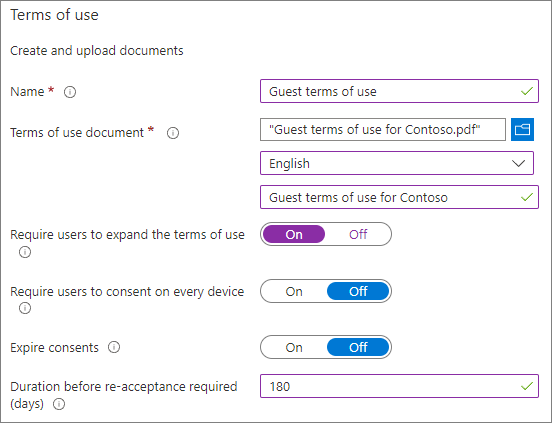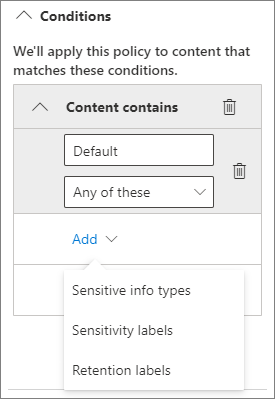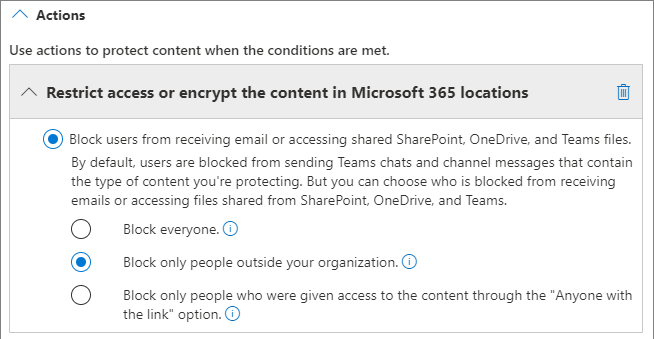In this article, we'll walk through a variety of options for creating a secure guest sharing environment in Microsoft 365. These are examples to give you an idea of the options available. You can use these procedures in different combinations to meet the security and compliance needs of your organization.
This article includes:
- Setting up multi-factor authentication for guests.
- Setting up a terms of use for guests.
- Setting up quarterly guest access reviews to periodically validate whether guests continue to need permissions to teams and sites.
- Restricting guests to web-only access for unmanaged devices.
- Configuring a session timeout policy to ensure guests authenticate daily.
- Creating a sensitive information type for a highly sensitive project.
- Automatically assigning a sensitivity label to documents that contain a sensitive information type.
- Automatically removing guest access from files with a sensitivity label.
Some of the options discussed in this article require guests to have an account in Azure Active Directory. To ensure that guests are included in the directory when you share files and folders with them, use the SharePoint and OneDrive integration with Azure AD B2B Preview.
Note that we won't discuss enabling guest sharing settings in this article. See Collaborating with people outside your organization for details about enabling guest sharing for different scenarios.
Set up multi-factor authentication for guests
Multi-factor authentication greatly reduces the chances of an account being compromised. Since guest users may be using personal email accounts that don't adhere to any governance policies or best practices, it's especially important to require multi-factor authentication for guests. If a guest user's username and password is stolen, requiring a second factor of authentication greatly reduces the chances of unknown parties gaining access to your sites and files.
In this example, we'll set up multi-factor authentication for guests by using a conditional access policy in Azure Active Directory.
To set up multi-factor authentication for guests
- Go to Azure conditional access policies.
- On the Conditional Access | Policies blade, click New policy.
- In the Name field, type a name.
- Under Assignments, click Users and groups.
- On the Users and groups blade, select Select users and groups, select the All guests and external users check box.
- Under Assignments, click Cloud apps or actions.
- On the Cloud apps or actions blade, select All cloud apps on the Include tab.
- Under Access controls, click Grant.
- On the Grant blade, select the Require multi-factor authentication check box, and then click Select.
- On the New blade, under Enable policy, click On, and then click Create.
Now, guest will be required to enroll in multi-factor authentication before they can access shared content, sites, or teams.
More information
Planning an Azure AD Multi-Factor Authentication deployment
Set up a terms of use for guests
In some situations guest users may not have signed non-disclosure agreements or other legal agreements with your organization. You can require guests to agree to a terms of use before accessing files that are shared with them. The terms of use can be displayed the first time they attempt to access a shared file or site.
To create a terms of use, you first need to create the document in Word or another authoring program, and then save it as a .pdf file. This file can then be uploaded to Azure AD.
To create an Azure AD terms of use
-
Sign in to Azure as a Global Administrator, Security Administrator, or Conditional Access Administrator.
-
Navigate to Terms of use.
-
Click New terms.

-
Type a Name and Display name.
-
For Terms of use document, browse to the pdf file that you created and select it.
-
Select the language for your terms of use document.
-
Set Require users to expand the terms of use to On.
-
Under Conditional Access, in the Enforce with Conditional Access policy template list choose Create conditional access policy later.
-
Click Create.
Once you've created the terms of use, the next step is to create a conditional access policy that displays the terms of use to guest users.
To create a conditional access policy
- Go to Azure conditional access policies.
- On the Conditional Access | Policies blade, click New policy.
- In the Name box, type a name.
- Under Assignments, click Users and groups.
- On the Users and groups blade, select Select users and groups, select the All guests and external users check box.
- Under Assignments, click Cloud apps or actions.
- On the Include tab, select Select apps, and then click Select.
- On the Select blade, select Microsoft Teams, Office 365 SharePoint Online, and Outlook Groups, and then click Select.
- Under Access controls, click Grant.
- On the Grant blade, select Guest terms of use, and then click Select.
- On the New blade, under Enable policy, click On, and then click Create.
Now, the first time a guest user attempts to access content or a team or site in your organization, they will be required to accept the terms of use.
Note
Using Conditional Access requires an Azure AD Premium P1 license. For more information, see What is Conditional Access.
More information
Azure Active Directory terms of use
Set up guest access reviews
With access reviews in Azure AD, you can automate a periodic review of user access to various teams and groups. By requiring an access review for guests specifically, you can help ensure guest users do not retain access to your organization's sensitive information for longer than is necessary.
Access reviews can be organized into programs. A program is a grouping of similar access reviews that can be used to organize access reviews for reporting and auditing purposes.
To create a program
- Sign in to the Azure portal and open the Identity Governance page.
- In the left menu, click Programs
- Click New program.
- Type a Name and Description.
- Click Create.
Once the program has been created, we can create a guest access review and associate it with the program.
To set up a guest user access review
-
On the Identity Governance page, in the left menu, click Access reviews.
-
Click New access review.

-
In the Name box, type a name.
-
For Frequency, choose Quarterly.
-
For End, choose Never.
-
For Scope, choose Guest users only.
-
Click Group, select the groups that you want to include in the access review, and then click Select.
-
Under Programs, click Link to program.
-
On the Select a program blade, choose Guest access review program
-
Click Start.
A separate access review is created for each group that you specify. Group owners of each group will be emailed quarterly to approve or deny guest access to their groups.
It's important to note that guests can be given access to teams or groups, or to individual files and folders. When given access to files and folders, guests may not be added to any particular group. If you want to do access reviews on guest users who don't belong to a team or group, you can create a dynamic group in Azure AD to contain all guests and then create an access review for that group. Site owners can also manage guest expiration for the site
More information
Manage guest access with Azure AD access reviews
Create an access review of groups or applications in Azure AD access reviews
Set up web-only access for guest users
You can reduce your attack surface and ease administration by requiring guest users to access your teams, sites, and files by using a web browser only.
For Microsoft 365 Groups and Teams, this is done with an Azure AD conditional access policy. For SharePoint, this is configured in the SharePoint admin center. (You can also use sensitivity labels to restrict guests to web-only access.)
To restrict guests to web-only access for Groups and Teams:
-
On the Conditional Access - Policies blade, click New policy.
-
In the Name box, type a name.
-
Under Assignments, click Users and groups.
-
On the Users and groups blade, select Select users and groups, select the All guests and external users check box.
-
Under Assignments, click Cloud apps or actions.
-
On the Include tab, select Select apps, and then click Select.
-
On the Select blade, select Microsoft Teams and Outlook Groups, and then click Select.
-
Under Assignments, click Conditions.
-
On the Conditions blade, click Client apps.
-
On the Client apps blade, click Yes for Configure, and then select the Mobile apps and desktop clients, Exchange ActiveSync clients, and Other clients settings. Clear the Browser check box.

-
Click Done.
-
Under Access controls, click Grant.
-
On the Grant blade, select Require device to be marked as compliant and Require Hybrid Azure AD joined device.
-
Under For multiple controls, select Require one of the selected controls, and then click Select.
-
On the New blade, under Enable policy, click On, and then click Create.
To restrict guests to web-ony access for SharePoint
- In the SharePoint admin center, expand Policies and click Access control.
- Click Unmanaged devices.
- Select the Allow limited, web-only access option, and then click Save.
Note that this setting in the SharePoint admin center creates a supporting conditional access policy in Azure AD.
Configure a session timeout for guest users
Requiring guests to authenticate on a regular basis can reduce the possibility of unknown users accessing your organization's content if a guest user's device isn't kept secure. You can configure a session timeout conditional access policy for guest users in Azure AD.
To configure a guest session timeout policy
- Go to Azure conditional access policies.
- On the Conditional Access - Policies blade, click New policy.
- In the Name box, type Guest session timeout.
- Under Assignments, click Users and groups.
- On the Users and groups blade, select Select users and groups, select the All guests and external users check box.
- Under Assignments, click Cloud apps or actions.
- On the Include tab, select Select apps, and then click Select.
- On the Select blade, select Microsoft Teams, Office 365 SharePoint Online, and Outlook Groups, and then click Select.
- Under Access controls, click Session.
- On the Session blade, select Sign-in frequency.
- Select 1 and Days for the time period, and then click Select.
- On the New blade, under Enable policy, click On, and then click Create.
Create a sensitive information type for a highly sensitive project
Sensitive information types are predefined strings that can be used in policy workflows to enforce compliance requirements. The Microsoft 365 Compliance Center comes with over one hundred sensitive information types, including driver's license numbers, credit card numbers, bank account numbers, etc.
You can create custom sensitive information types to help manage content specific to your organization. In this example, we'll create a custom sensitive information type for a highly sensitive project. We can then use this sensitive information type to automatically apply a sensitivity label.
To create a sensitive information type
- In the Microsoft 365 Compliance Center, in the left navigation, expand Classification, and then click Sensitive info types.
- Click Create.
- For Name and Description, type Project Saturn, and then click Next.
- Click Add an element.
- On the Detect content containing list, select Keywords, and then type Project Saturn in the keyword box.
- Click Next, and then click Finish.
- If asked if you would like to test the sensitive information type, click No.
More information
Custom sensitive information types
Create an auto-labeling policy to assign a sensitivity label based on a sensitive information type
If you are using sensitivity labels in your organization, you can automatically apply a label to files that contain defined sensitive information types.
To create an auto-labeling policy
- Open the Microsoft 365 compliance admin center.
- In the left navigation, click Information protection.
- On the Auto-labeling tab, click Create auto-labeling policy.
- On the Choose info you want this label applied to page, choose Custom and click Next.
- Type a name and description for the policy and click Next.
- On the Choose locations where you want to apply the label page, turn on SharePoint sites and click Choose sites.
- Add the URLs for the sites where you want to turn on auto-labeling and click Done.
- Click Next.
- On the Set up common or advanced rules page, choose Common rules and click Next.
- On the Define rules for content in all locations page, click New rule.
- On the New rule page, give the rule a name, click Add condition, and then click Content contains sensitive info types.
- Click Add, click Sensitive info types, choose the sensitive info types that you want to use, click Add, and then click Save.
- Click Next.
- Click Choose a label, select the label you want to use, and then click Add.
- Click Next.
- Leave the policy in simulation mode and click Next.
- Click Create policy, and then click Done.
With the policy in place, when a user types "Project Saturn" into a document, the auto-labeling policy will automatically apply the specified label when it scans the file.
More information
Apply a sensitivity label to content automatically
Create a DLP policy to remove guest access to highly sensitive files
You can use data loss prevention (DLP) to prevent unwanted guest sharing of sensitive content. Data loss prevention can take action based on a file's sensitivity label and remove guest access.
To create a DLP rule
-
In the Microsoft 365 compliance admin center, go to the Data loss prevention page.
-
Click Create policy.
-
Choose Custom and click Next.
-
Type a name for the policy and click Next.
-
On the Locations to apply the policy page turn off all settings except SharePoint sites and OneDrive accounts, and then click Next.
-
On the Define policy settings page, click Next.
-
On the Customize advanced DLP rules page, click Create rule and type a name for the rule.
-
Under Conditions, click Add condition, and choose Content contains.
-
Click Add, choose Sensitivity labels, choose the labels you want to use, and click Add.

-
Under Actions click Add an action and choose Restrict access or encrypt the content in Microsoft 365 locations.
-
Select the Restrict access or encrypt the content in Microsoft 365 locations check box and then choose the Only people outside your organization option.

-
Click Save and then click Next.
-
Choose your test options and click Next.
-
Click Submit, and then click Done.
It's important to note that this policy doesn't remove access if the guest is a member of the site or team as a whole. If you plan to have highly sensitive documents in a site or team with guest members, consider using private channels in Teams and only allowing members of your organization in the private channels.
Additional options
There are some additional options in Microsoft 365 and Azure Active Directory that can help secure your guest sharing environment.
- You can create a list of allowed or denied sharing domains to limit who users can share with. See Restrict sharing of SharePoint and OneDrive content by domain and Allow or block invitations to B2B users from specific organizations for more information.
- You can limit which other Azure Active Directory tenants your users can connect to. See Use tenant restrictions to manage access to SaaS cloud applications for information.
- You can create a managed environment where partners can help manage guest accounts. See Create a B2B extranet with managed guests for information.
See Also
Limit accidental exposure to files when sharing with guests
Best practices for sharing files and folders with unauthenticated users
Comments
0 comments
Please sign in to leave a comment.